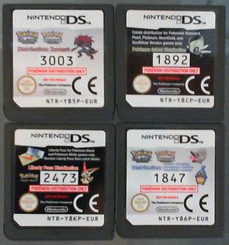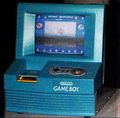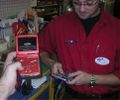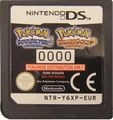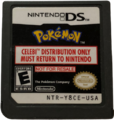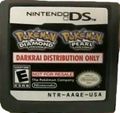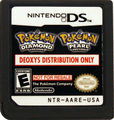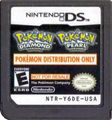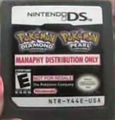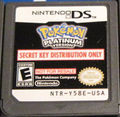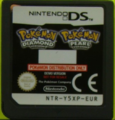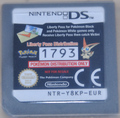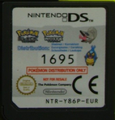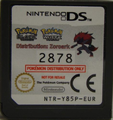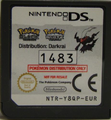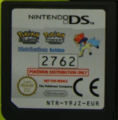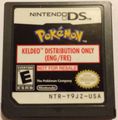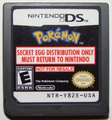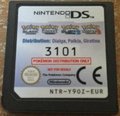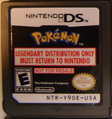Distribution device: Difference between revisions
mNo edit summary |
(It's the same machine, officially they were called マシン (Machine) or 特製マシン (Special Machine) by Nintendo, Shogakukan and even IGN - https://www.ign.com/articles/2000/09/01/getting-serebii) |
||
| Line 4: | Line 4: | ||
'''Distribution devices''' are special devices that are used to distribute [[event Pokémon|Pokémon events]]. | '''Distribution devices''' are special devices that are used to distribute [[event Pokémon|Pokémon events]]. | ||
Distribution devices include | Distribution devices include Pokémon machines, distribution cartridges, [[Pokémon Colosseum Bonus Disc]]s, European and Australian versions of [[Pokémon Channel]], the [[Nintendo GameCube|GameCube]] Interactive Multi-Game Demo Disc Version 14 and 16, [[Game Link Cable]]s, [[Game Boy Advance Wireless Adapter]]s, and infrared. However, other methods of distributing events includes [[Nintendo Wi-Fi Connection|Wi-Fi]] and mailing in a game cartridge. | ||
Machines were used to distribute most {{p|Mew}} events during [[Generation I]] and {{p|Celebi}} events during [[Generation II]]. Game Link Cables were used to distribute many events until the start of [[Generation IV]]. Starting in [[Generation V]], infrared was used to distribute certain events in Japan and {{pmin|South Korea}}. | |||
Distribution cartridges are given to stores for event distributions, and are not sold commercially. Starting in [[Generation IV]], they only contain information for the event Pokémon, and have no actual game data or save possibilities. These cartridges use [[DS Wireless Communications]] to distribute events starting in Generation IV. At the end of an event, they are intended to be sent to Nintendo's Waste Management facility in Redmond, Washington, where they are presumably destroyed. However, sometimes, distribution cartridges are leaked or sold to the public. | Distribution cartridges are given to stores for event distributions, and are not sold commercially. Starting in [[Generation IV]], they only contain information for the event Pokémon, and have no actual game data or save possibilities. These cartridges use [[DS Wireless Communications]] to distribute events starting in Generation IV. At the end of an event, they are intended to be sent to Nintendo's Waste Management facility in Redmond, Washington, where they are presumably destroyed. However, sometimes, distribution cartridges are leaked or sold to the public. | ||
| Line 15: | Line 15: | ||
===Generation I=== | ===Generation I=== | ||
<gallery> | <gallery> | ||
Mew machine.jpg| | Mew machine.jpg| Special machine for distributing {{DL|List of Japanese event Pokémon distributions in Generation I|Nintendo Space World '99 Mew}} | ||
Distribution system Generation I.jpg|Distribution system used in [[Generation I]] | Distribution system Generation I.jpg|Distribution system used in [[Generation I]] | ||
</gallery> | </gallery> | ||
| Line 21: | Line 21: | ||
===Generation II=== | ===Generation II=== | ||
<gallery> | <gallery> | ||
Celebi machine.jpg| | Celebi machine.jpg| Special machine for distributing {{DL|List of European language event Pokémon distributions in Generation II|Pokémon Fun Fest Celebi}} | ||
Gotta Catch 'Em All Station.jpg|[[New York Pokémon Center]]'s Gotta Catch 'Em All Station | Gotta Catch 'Em All Station.jpg|[[New York Pokémon Center]]'s Gotta Catch 'Em All Station | ||
</gallery> | </gallery> | ||
Revision as of 13:32, 21 February 2021

|
This article is incomplete. Please feel free to edit this article to add missing information and complete it. Reason: Additional distribution methods |
Distribution devices are special devices that are used to distribute Pokémon events.
Distribution devices include Pokémon machines, distribution cartridges, Pokémon Colosseum Bonus Discs, European and Australian versions of Pokémon Channel, the GameCube Interactive Multi-Game Demo Disc Version 14 and 16, Game Link Cables, Game Boy Advance Wireless Adapters, and infrared. However, other methods of distributing events includes Wi-Fi and mailing in a game cartridge.
Machines were used to distribute most Mew events during Generation I and Celebi events during Generation II. Game Link Cables were used to distribute many events until the start of Generation IV. Starting in Generation V, infrared was used to distribute certain events in Japan and South Korea.
Distribution cartridges are given to stores for event distributions, and are not sold commercially. Starting in Generation IV, they only contain information for the event Pokémon, and have no actual game data or save possibilities. These cartridges use DS Wireless Communications to distribute events starting in Generation IV. At the end of an event, they are intended to be sent to Nintendo's Waste Management facility in Redmond, Washington, where they are presumably destroyed. However, sometimes, distribution cartridges are leaked or sold to the public.
No distribution cartridges are known to exist for event distributions for the post-Generation V games.
Images
Generation I
Special machine for distributing Nintendo Space World '99 Mew
Distribution system used in Generation I
Generation II
Special machine for distributing Pokémon Fun Fest Celebi
New York Pokémon Center's Gotta Catch 'Em All Station
Generation III
Waiting for a distribution in Generation III
Distribution system used for the Top 10 Pokémon
Mystery Mew link trade distribution
Distribution system used in Generation III
Generation IV
Waiting for a distribution in Generation IV
Active distribution in Generation IV
Expired distribution in Generation IV
European Michina Arceus distribution DS card
Toys "R" Us Arceus distribution DS card
European Winter 2011 Celebi distribution DS card
Americas Winter 2011 Celebi distribution DS card
Toys "R" Us Darkrai distribution DS card
GameStop Deoxys distribution DS card
Toys "R" Us Dragonite distribution DS card
GameStop Pikachu-colored Pichu and GameStop Jirachi distribution DS card
GameStop legendary beasts (and undistributed Celebi) distribution DS card
Toys "R" Us Manaphy distribution DS card
Toys "R" Us Ash's Pikachu distribution DS card
US Secret Key distribution DS card
Movie 11 Shaymin distribution DS card
10th Movie Deoxys distribution Slot 2 cartridge
Generation V
Waiting for a distribution in Generation V
Active distribution in Generation V
Expired distribution in Generation V
European Liberty Ticket distribution cartridge
European Summer 2011 Karrablast and Summer 2011 Shelmet distribution cartridge
European Summer 2011 Zoroark distribution cartridge
US Zoroark Month Zoroark distribution cartridge
European Winter 2011 Darkrai distribution cartridge
European Summer 2012 Keldeo distribution cartridge
US Summer 2012 Keldeo distribution cartridge
European Spring 2013 Meloetta distribution cartridge
US Spring 2013 Meloetta distribution cartridge
US Secret Eggs distribution cartridge
European International Summer 2013 Shiny creation trio distribution cartridge
United States Summer 2013 Shiny creation trio distribution cartridge
See also

|
This game-related article is part of Project Games, a Bulbapedia project that aims to write comprehensive articles on the Pokémon games. |
